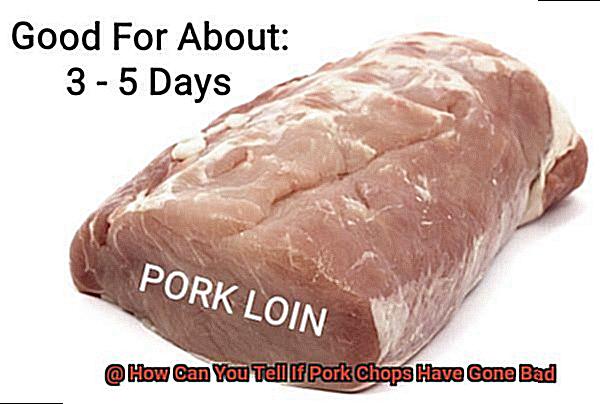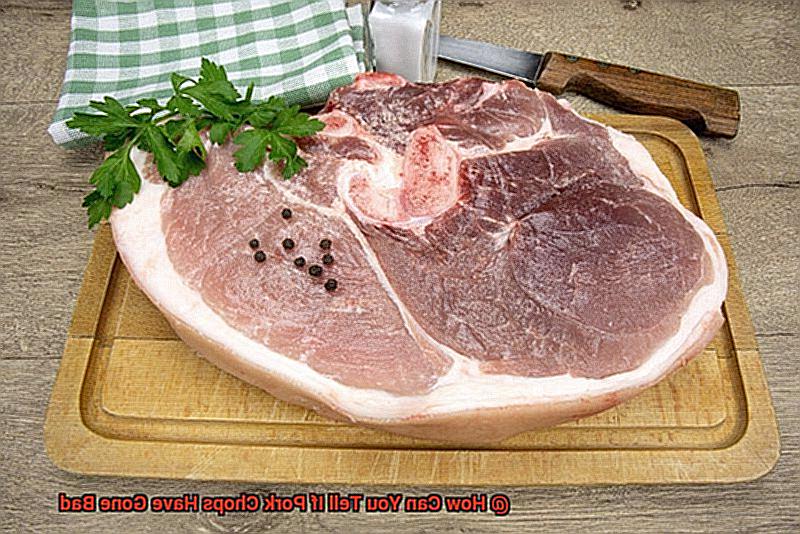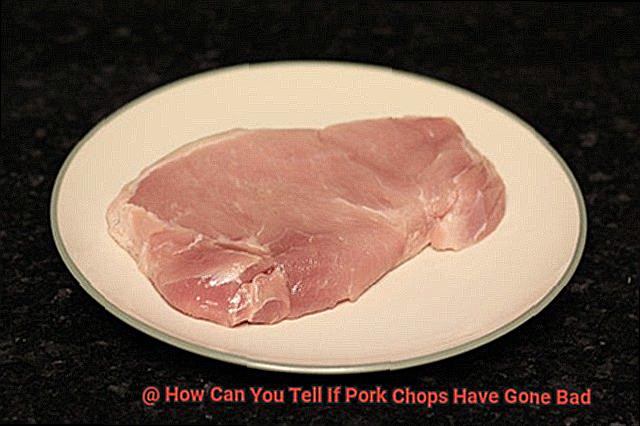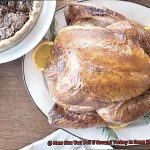Pork chops are undoubtedly one of the most delectable dishes that you can savor. However, with great taste comes great responsibility – the responsibility of ensuring that your pork chops are fresh and free from spoilage. Nobody wants to suffer from food poisoning or stomach upset after consuming their favorite meal. So, how can you tell if pork chops have gone bad?
Well, it’s simple. Your senses will come in handy here. Use your sense of smell, sight, and touch to identify any signs of spoilage in pork chops. The first thing to check is the smell. Spoiled pork chops have a distinct odor like rotten eggs or sulfur that should immediately alert you. Secondly, observe the color of the pork chops; they should be pink or brownish-pink when fresh. Any discoloration like grey, green, or brown is a clear indication that the pork chop has gone bad. Finally, pay attention to the texture of the meat; fresh pork chops feel firm when touched. If it feels slimy, then it’s time to toss it out as bacterial growth has taken over.
In this blog post, we’ll discuss all the different signs that indicate whether your pork chops have gone bad or not. We’ll also share some pro tips on how to store your pork chops correctly to prevent spoilage and ensure maximum freshness and flavor retention. Trust us; with this information at your fingertips, you’ll always enjoy safe and nourishing pork chops that will keep you coming back for more.
Contents
Checking the Expiration Date: How to determine if your pork chops are past their expiration date
Pork chops are a mouth-watering delicacy that many people love to indulge in. However, it’s crucial to ensure that they are safe to consume. The last thing you want is to experience food poisoning due to expired or spoiled pork chops. To avoid this, here’s what you need to know about checking the expiration date and determining if your pork chops have gone bad.
Firstly, always check the expiration date on the package before purchasing and consuming pork chops. Typically, pork chops have a shelf life of three to five days if they are stored correctly in the refrigerator at 40°F or below. If the expiration date has passed, it’s best to err on the side of caution and discard the pork chops. Consuming expired meat can lead to severe foodborne illnesses such as salmonella, listeria, and E. coli.
Besides checking the expiration date, it’s vital to inspect the pork chops for signs of spoilage. Any off odor or slimy texture is a clear indication that they have gone bad and should be thrown away immediately. A sour or ammonia-like smell is also a red flag that your pork chops have spoiled and should not be consumed.
It’s important to note that not all signs of bad pork chops are visible. Bacteria can grow on the meat even if it looks and smells fine, causing illness when consumed. Therefore, it’s essential to cook pork chops to an internal temperature of 145°F to kill any harmful bacteria.
To ensure your safety and that of those consuming your food, always use caution when handling raw meat and follow proper cooking and storage procedures. Proper handling includes keeping pork chops in the fridge or freezer until ready to use and promptly cooking them after thawing.
Giving it a Sniff: What foul or sour odor indicates that the pork chops have gone bad

There’s nothing quite like the taste of a juicy, succulent pork chop for dinner. But what happens when your beloved meat has gone bad? You definitely don’t want to find out. That’s why it’s crucial to know how to tell if your pork chops have gone bad, and the best way to do that is by using your sense of smell.
So, which foul or sour odor indicates that the pork chops have gone bad? It’s easy to recognize. If you detect a distinct scent of sulfur and ammonia coming from your pork chops, it’s time to toss them out. This unpleasant odor is caused by the breakdown of proteins in the meat and can be compared to the smell of rotten eggs – not exactly appetizing, huh?
But wait – don’t panic just yet if your pork chops have a slight odor when first taken out of the packaging. This is normal and should dissipate after a few minutes. However, if the smell becomes stronger or lingers, it’s better to be safe than sorry and discard the meat.
Aside from a foul or sour odor, other indicators of spoiled pork chops include a slimy texture, discoloration, or a sticky film on the surface. These are all signs that bacteria have started to grow on the meat and consuming it could lead to food poisoning.
To avoid getting sick from spoiled pork chops, always practice proper food safety measures such as checking the expiration date before purchasing, storing in the refrigerator at 40°F or below, cooking to an internal temperature of 145°F, and avoiding cross-contamination with other raw meats or foods.
The Texture and Color Test: How slimy texture or discolored meat can be an indication of spoilage
After all, nobody wants to take a bite of a bad pork chop and ruin their appetite.
First and foremost, let’s discuss texture. Fresh pork chops should feel firm and smooth to the touch. However, if you feel a slimy or sticky film on the surface of your meat, it’s time to toss it out. This slimy texture is caused by bacteria growth and is a surefire sign that your pork chop has gone bad.
Now, onto color. Fresh pork chops should have a pinkish-red hue, but as they age, their color can change to a grayish-brown shade. While some browning on the surface is normal due to exposure to air, green or blue discoloration is not. If you spot any unusual color changes in your pork chop, it’s best to play it safe and discard it.
It’s important to use all your senses when checking for spoilage. Trust your nose and discard any pork chops that emit an unpleasant odor resembling sulfur or ammonia. Additionally, keep an eye out for any signs of mold or unusual spots on the meat.

To sum up, here’s a quick checklist to keep in mind when testing the texture and color of your pork chops:
- Texture: Firm and smooth = good; Slimy or sticky = bad
- Color: Pinkish-red or grayish-brown (with no green or blue discoloration) = good; Any unusual colors = bad
- Smell: No unpleasant odors = good; A strong sulfur or ammonia smell = bad
- Mold or unusual spots = bad
Hidden Bacteria: The dangers of not being able to see bacteria on pork chops
Pork chops are a classic dish enjoyed by many, but the potential danger of hidden bacteria lurking on them is not always considered. Raw pork can harbor various types of bacteria, including Salmonella and Listeria, which can cause severe food poisoning. The issue with these bacteria is that they can’t be seen with the naked eye, leaving consumers unaware if their pork is contaminated or not.
To avoid the dangers of hidden bacteria on pork chops, it’s crucial to take extra precautions when handling raw pork. Washing hands thoroughly before and after handling pork and cleaning any surfaces or utensils that come into contact with the meat are important steps in preventing bacterial contamination. Additionally, cooking pork to an internal temperature of at least 145°F kills any bacteria present.
Aside from Salmonella and Listeria, other harmful bacteria such as Clostridium perfringens and Staphylococcus aureus can also be found on raw pork. Consumption of these bacteria can lead to symptoms such as nausea, vomiting, diarrhea, and abdominal pain.
To ensure safety when consuming pork chops, always purchase fresh pork from a reputable source and cook it thoroughly to avoid the risks of hidden bacteria. By implementing these simple precautions, you can savor safe and delicious pork chops without compromising your health.
Cooking Pork Chops Safely: The importance of cooking pork chops to an internal temperature of 145°F
Let’s dive into the reasons why.
Let’s start with the risks of undercooked pork. The meat can carry harmful bacteria such as Salmonella, E. coli, and Listeria, which can lead to foodborne illnesses ranging from mild to severe symptoms. To avoid these risks, it’s essential to cook pork to the proper temperature.
Cooking pork chops to an internal temperature of 145°F is the magic number that kills any harmful bacteria in your meat. Using a meat thermometer is the best way to ensure that you’re cooking your pork chops accurately. Insert the thermometer into the thickest part of the meat, and voila. You have an accurate reading.
Now, some may fear overcooking their pork chops and rendering them dry. However, cooking your pork chops to this temperature will ensure that they’re safe to eat while still retaining their juiciness and tenderness. Larger cuts of pork, such as roasts and tenderloins, should be cooked to an internal temperature of 160°F for added safety.
In addition to cooking your pork chops correctly, it’s vital to handle raw pork with care. Always wash your hands thoroughly with hot soapy water before and after handling it and sanitize any surfaces in contact with raw meat. Use separate cutting boards and utensils for raw and cooked meats to prevent cross-contamination. Lastly, refrigerate leftover cooked pork within two hours of serving it.
Err on the Side of Caution: Why it’s better to throw away questionable pork chops
Before you do, it’s crucial to handle them with care to avoid getting sick from harmful bacteria. Pork is notorious for harboring Salmonella and E. coli, which can cause foodborne illnesses if ingested. And if pork is not stored properly, it can serve as a breeding ground for these pathogens to multiply and spread.
To determine if your pork chops are still safe to eat, here are some key signs to look out for. Firstly, check the color of the meat. Fresh pork should be pale pink with marbling throughout the meat. If the meat appears discolored in any way or has a grayish tint, it’s best to err on the side of caution and throw it away.
Your sense of smell is another helpful tool in determining whether your pork chops have gone bad. Fresh pork should have a mild, slightly sweet odor. If the meat smells sour or rancid in any way, it’s a clear sign that it has spoiled and should be discarded immediately.
The touch test is also useful in detecting spoiled pork chops. Fresh pork should feel firm and springy to the touch, with no sliminess or stickiness present on the surface of the meat. If the meat feels slimy or sticky, it’s a sign that bacteria has started to grow and that the meat has spoiled.
By throwing away questionable pork chops, you’re not only avoiding potential illness but also ensuring that you serve safe and delicious meals every time. Remember always to handle raw pork with care by washing your hands thoroughly, sanitizing surfaces, and using separate cutting boards and utensils for raw and cooked meats.
Proper Handling and Storage: Tips for keeping pork chops fresh for longer periods of time
Proper handling and storage of pork chops is essential for maintaining their freshness and safety. In this article, we will discuss the importance of temperature control, safe handling, packaging, proper thawing, and expiration dates.
Temperature Control
Storing pork chops at the right temperature is crucial for preventing the growth of harmful bacteria. Keep them at or below 40°F (4°C) in the coldest part of your fridge. This will help to ensure that they stay fresh and safe to eat for longer periods of time.
Safe Handling
Raw pork can contain harmful bacteria such as Salmonella and E. coli, so it’s important to handle it safely. Always wash your hands thoroughly before and after handling raw pork, and clean any utensils or surfaces that come into contact with it. This will help prevent cross-contamination and reduce the risk of foodborne illness.
Packaging
Pork chops should be kept in their original packaging until you’re ready to cook them. If you need to store them for an extended period, consider repackaging them in airtight containers or freezer bags to prevent moisture loss and freezer burn. When freezing, wrap tightly in plastic wrap or aluminum foil for added protection.
Thawing
When thawing your pork chops, do so safely by placing them in the refrigerator overnight instead of leaving them out at room temperature. Thawing at room temperature can lead to bacterial growth and increase the risk of foodborne illness. It’s best to plan ahead and allow enough time for safe thawing in the fridge.
Expiration Date
Always check the sell-by date on your pork chops to ensure that they are fresh. If they have gone past their expiration date or have a foul odor, dispose of them right away. Eating expired meat can lead to food poisoning and other health risks.
Alternative Uses for Spoiled Pork Chops: Ideas for using spoiled pork chops in creative ways
Today, we’re going to explore an unusual topic: alternative uses for spoiled pork chops. While it’s always best to handle and store meat properly to prevent spoilage, sometimes things just don’t go as planned. But don’t worry, there are still some innovative ways to make use of those spoiled pork chops.
First on our list is using them as fishing bait. Surprisingly, the strong odor of spoiled pork can actually attract fish, making it a unique alternative to traditional bait. So next time you’re out on the water, consider bringing along some spoiled pork chops to enhance your fishing game.
Another option is using the spoiled pork chops as compost or fertilizer for your plants. The decomposing meat can provide valuable nutrients for the soil, helping your plants thrive and grow.
If you’re feeling adventurous and want to make something out of those spoiled pork chops, try making broth or stock. While the meat itself may not be safe to eat, it can still be used to flavor a broth or stock. Simply simmer the pork chops in water with some vegetables and spices for a few hours, then strain out the solids to create a flavorful broth that can be used in soups, stews, and other dishes.
Finally, if you have a furry friend at home, consider making dog food from the spoiled pork chops. Although it may not be safe for humans to eat spoiled meat, dogs can often handle it without any issues. Just remember to cook the pork chops thoroughly and mix them with some vegetables and rice to create a nutritious meal for your pup.
Of course, it’s always best to prevent spoilage by properly storing and handling meat. Keep it refrigerated or frozen until ready to cook, and always cook it thoroughly to ensure it’s safe to eat.
XSVTNUBteMg” >
Conclusion
In conclusion, indulging in a succulent pork chop meal is a delight for the senses, but ensuring their safety is paramount. To determine if your pork chops have gone bad, use your senses of smell, sight, and touch. Always check the expiration date on the package before purchasing and consuming pork chops to avoid any potential risks.
It’s important to note that not all signs of spoilage are visible. Harmful bacteria can grow on meat even if it looks and smells fine, leading to illness when consumed. Therefore, handling raw meat with care is crucial for your health. Follow proper cooking and storage procedures such as cooking pork chops to an internal temperature of 145°F.
Proper handling includes keeping pork chops chilled in the fridge or freezer until ready to use and promptly cooking them after thawing. Additionally, washing hands thoroughly before and after handling raw pork and sanitizing any surfaces or utensils that come into contact with the meat prevents bacterial contamination.
If you suspect that your pork chops have gone bad, don’t take any chances – discard them immediately. While there are alternative uses for spoiled pork chops such as fishing bait or composting material, it’s always best to prevent spoilage by properly storing and handling meat.






